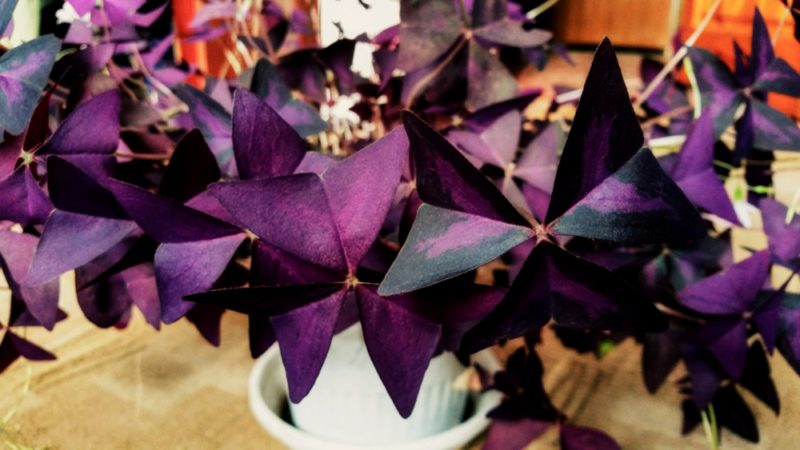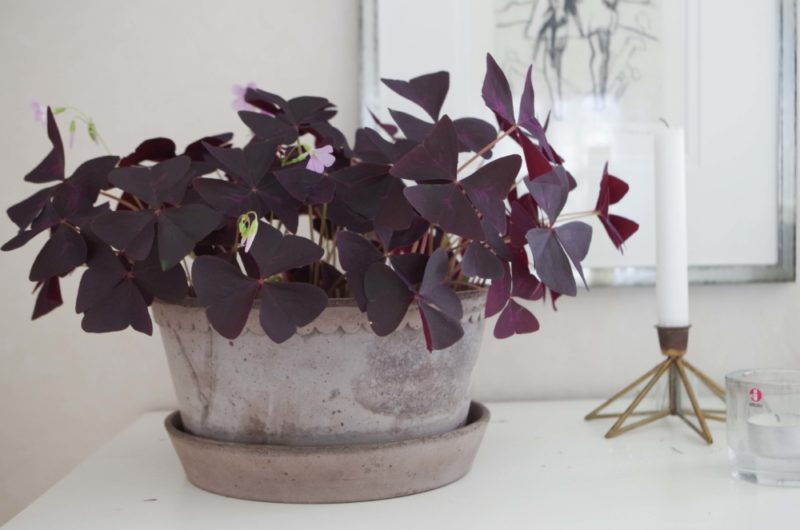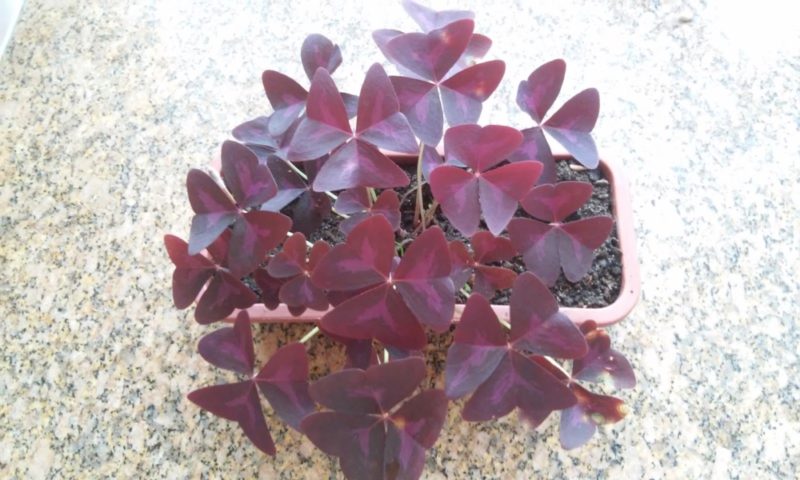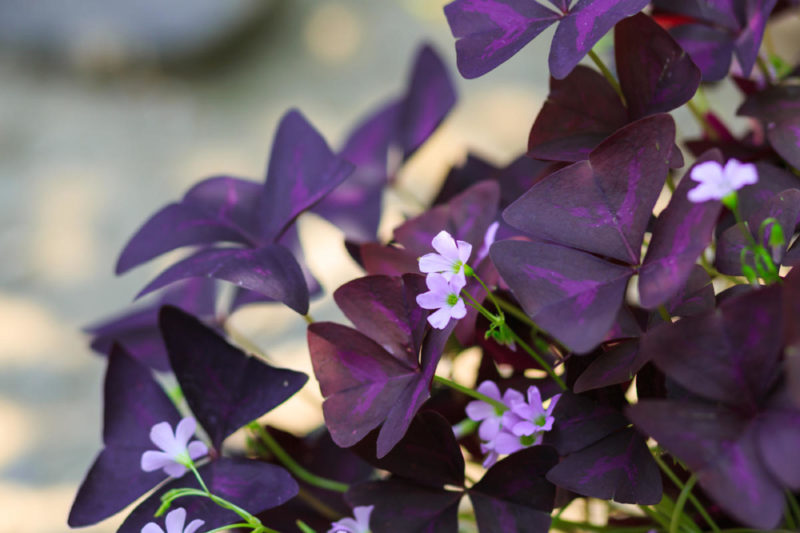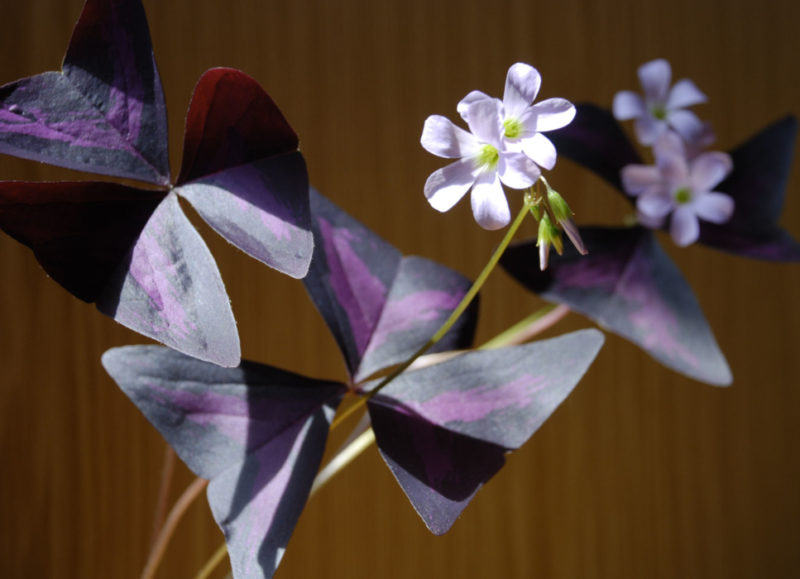The popular oxalis has attracted indoor flower lovers for its modest beauty for many years. Unlike each other, varieties are pleasing to the eye, and connoisseurs vying with each other insist on the positive effect of sour acid on the house and the people living in it.
Material Content:
Botanical description of sour
Oxalis, or sour, is called the representative of the genus of fast-growing annuals and perennials belonging to the family of Spermids.
- Clawed or cirrus leaf blades of plants are green, burgundy or purple. Their average diameter is from 5 to 15 cm. The leaves on the specimen are usually painted in different shades of the same color, but there are also variegated species.
- Umbrella flowers are located on high peduncles. There are varieties with petals of white, pink, orange, reddish and yellow color. The flowers are small, with a diameter, on average, up to 1.5 - 2 cm. They close with the onset of night or during a period of worsening weather conditions.
- They have the ability to fold and leaves. They merge with the advent of the dark, due to mechanical stress or due to bright sunlight.
- After flowering, fruit boxes are tied. They consist of separate nests in which the seeds are located in the fleshy membrane. When ripe, the boxes increase in size and burst, the seed material enters the ground. In this way, the propagation of culture is carried out in nature.
In some countries, tuberous roots of certain types of oxalis are consumed.
- Means based on the sour plant are used in alternative medicine. They improve appetite, lower blood pressure and stabilize the circulatory system. The flower is used for skin diseases and lesions of the oral mucosa, is used as an anthelmintic and antacid.
Types and varieties of plants
In total, there are approximately 800 species of oxalis. Some of them can only be found in the wild. There are varieties and varieties of sour acid, which are grown in greenhouse conditions or as an indoor flower.
The most popular of them:
- Purple Sour - a plant up to 12 cm high, which can be cultivated in a house or in the garden. It has saturated burgundy leaves with a rounded shape, a diameter of about 7 cm. Flowers of white or pinkish color.
- Multicolored oxalis versicolor attracts with its original flowers, on the petals of which areas of white and red color are connected. Plant height - up to 15 cm. At home, flowering continues almost all year round.
- The Golden Cape variety conquers with decorative pale green foliage and amazingly beautiful red-yellow inflorescences.
- Oxalis “Iron Cross” (Depp sour) is one of the most beloved species in indoor floriculture. Its two-tone leaves resemble clover. They consist of four parts, each center is brownish-burgundy, and the outer part is bright green. Inflorescences are small, light red.
- Triangular acid has leaf blades of two shades of purple. There are several varieties of plants that differ in the color of flower petals. There is a triangular acid, which pleases with white, purple or pink inflorescences. The species does not tolerate freezing, so they try not to plant it in open ground.
- Pink acid is often grown as an ampel plant. The people call this oxalis with bright green leaves a clover of happiness. He has flowers of saturated pink color about 3 cm in size, which are densely dotted with sour in the spring and summer.
- Pressed oxalis grows up to 20 cm. It has grayish-green leaves and flower petals of a saturated pink color with a yellow core.
Carob acid is a common weed plant. Outwardly, she looks like her decorative relatives. This is a small oxalis, with brownish-cherry leaves and yellow flowers. It has increased resistance to adverse environmental conditions.
Features of cultivation and care
Unpretentious and cute sour acid can often be found in home flower collections.
Getting a healthy and beautiful plant is easier if you know some of the nuances of its content:
- Usually in winter, sour acid grows weaker and blooms worse. It's not scary, the flower is resting. It is necessary to reduce the amount of watering, it is desirable to keep it in a cool room.
- In many instances, in the cold season, the ground part of the plant partially or completely dies. This is a normal occurrence. After about 1 to 2 months, sour acid comes to life and begins to grow new leaves. During hibernation, it is advisable to place the oxalis flower in a dark and cool place. Watering during this period requires rare.
The periods of rest may shift, differ in dissimilar varieties and even in different specimens of the same species. Without a dormant period, the sour flower blooms worse.
Oxalis needs minimal additional care:
- Faded inflorescences and dried leaves are regularly removed.
- Timely feed and transplant the plant.
- Oxygen is rarely sick and suffers from pests. In case of health problems, therapeutic measures are carried out. Depending on the situation, various chemical preparations are used, and the conditions of detention are changed.
Lighting and location
In nature, sour acid grows without problems in the shade of large trees. At home, she will need diffused soft light. With strong shading, it grows worse, blooms a little, and the color intensity of the leaves may change.
Oxalis can withstand the direct rays of the sun in the morning, but you can not keep it in the sun in the heat. This can lead to burns on the leaves. Over the course of the year, the plant will feel good on the southwestern or southeastern window, shading from the bright sun in the midday summer hours. On the southern windowsill it can be put in the autumn-winter period. At this time, solar activity is reduced, and oxalis suffers due to short daylight hours.
Approximately, from May to October, if there is no threat of frost, the flower will like in the garden or on the open veranda. It can be taken outside and left in a pot, or transplanted into open ground before the onset of cold weather.
The flower is taught to fresh air gradually; he does not like sudden changes in temperature. On the street do not place the plant in direct sunlight, it is better to put it in partial shade.
Temperature mode
Optimal temperatures for oxalis depend on the time of year. In spring and summer, during the period of active growth, the flower feels best at a temperature of 22 to 25 degrees Celsius. In winter, sour development slows down. During rest, she will appreciate a cooler room, with a temperature of about +17 degrees.
Soil requirement
It is not recommended to plant acid in lime ground. A neutral soil or slightly acidic substrate for flowering plants is more suitable. Ready-made sandy soil mix for cacti can be used.
The flower will appreciate the loose and fertile land. When planting oxalis, a drainage layer is necessarily placed on the bottom of the pot.
Watering, fertilizing and fertilizing
In summer and spring, sour is in a phase of active development. During this period, it is watered on average twice a week, abundantly. In extreme heat, daily moisturizing may be necessary. With the onset of cold weather, the amount of irrigation is gradually reduced. Oxalis does not need spraying, it normally tolerates reduced air humidity. Warm shower is appropriate to apply only during extreme heat. In this case, you must ensure that direct sunlight does not fall on the plant covered with drops of water.
Oxalis does not like overdrying. With regular underfilling, the decorativeness of sour acid deteriorates, it is often sick and blooms worse. Stagnation of water in the ground should also not be allowed. Excessive watering can provoke the development of fusarium or gray rot.
From April to August, an average of 1 to 2 times a month feed sour acid. Use complex fertilizers for flowering indoor plants. During the rest period, additional nutrition is not necessary.
Flower transplant
The procedure is best performed at the beginning of the growing season, in cloudy weather. Oxalis is transplanted quite often, usually annually or every other year. The pot is not necessarily deep, but wide. If the division is carried out, the volume of the pot can not be changed. If the flower is only planned to be transplanted, larger containers are needed. Usually enough capacity, whose diameter is 2 - 3 cm more than the old. Prepared soil mixtures for flowering plants with neutral acidity and high potassium content are used as a substrate.
Transplantation Stages:
- Water the plant liberally with settled water.
- Pour boiling water over the container and lay on its bottom a drainage layer of expanded clay or clay shards.
- To fill part of the earth in a new flowerpot.
- Carefully remove the oxalis from the old pot and, if necessary, separate it. Remove damaged, rotten roots, old earth on the root system.
- Place the flower in a new container without immersing it too much in the ground. The average depth of root placement is from 3 to 5 cm.
- Smooth out the root system and the terrestrial part of the sour.
- Fill the flower pot with soil, then lightly tamp the substrate.
- Water the plant, if necessary add a little more soil and re-moisten.
- Allow excess moisture to drain and transfer oxalis to a place with diffused light.
In the summer, sour acid, if desired, is planted in open ground.It is possible to carry out work after the earth has warmed up well and the threat of frost has passed. Depending on the region, this happens in April - May. Choose a site on which loose soil, with good drainage abilities. If the soil is heavy, add a little peat or sand. Fertilizers are additionally added to the area with bad land.
For the winter, such plants are dug up and transferred to a dry, darkened and cool room. Or used in indoor floriculture.
Propagation of Sour
You can get new instances of oxalis in different ways:
- The division of the bush is most often carried out during transplantation, at the beginning of the growing season. The overgrown specimen is neatly divided into several parts depending on size, being careful not to damage the fragile tubers. Then planted in different pots.
- Seed propagation at home is not used. It is appropriate to apply only in the process of breeding.
- Small tubers and bulbs can also be planted in separate containers. It should be borne in mind that the smaller the number of rhizome segments, the weaker the acidity grows. So, decorativeness will suffer, and the number of inflorescences will be small.
- In cut lignified cuttings with several leaves, roots appear in about two weeks if kept in water. Such shoots are planted in pots of a suitable size. In one pot, it is better to place several young specimens at a short distance from each other, so that over time you get a large bush of a beautiful shape.
Signs and superstitions
Only positive beliefs are associated with acidity:
- The plant is recommended to grow in order to avoid conflicts and omissions in the family. It is called a charm of the house.
- Lonely people are advised to grow a flower in order to find a mate. They say that he attracts love to his home.
- It is believed that luck and luck come with this plant. A good omen is to give oxalis for a housewarming party or some other holiday, according to some European countries.
- There is a belief that a flower brings its owner material wealth and happiness.
Bright acidic cheers up, helps to defeat depression. It is recommended to keep it in the house for those who lead an active lifestyle, overwork and often suffer from mood swings.
Oxalis is an unpretentious and lovely representative of indoor flora. Among a large number of flower varieties, it will be possible to find a favorite taking into account personal preferences. And positive signs and superstitions are a wonderful occasion to create an original composition from unequal sour acids. In this set, you can easily collect several plants that will differ in the color of foliage and inflorescences.


